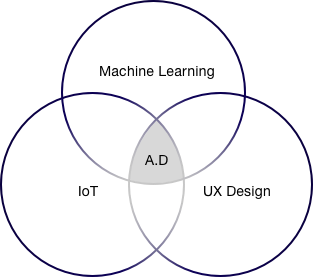Anticipatory Design is possibly the next big leap within the field of Experience Design. “Design that is one step ahead” as Shapiro refers to it. This sounds amazing, but where does it lead us? And how will it affect our relationship with technology?
I’ve dedicated my Master thesis to this topic to identify both ethical as design challenges that come with the development of predictive UX and application of Anticipatory Design as design pattern. With as overarching question “How Anticipatory Design might challenge our relationship with technology”.
A Future Without Choice
Anticipatory Design is an upcoming design pattern within the field of predictive user experiences (UX). The premise behind this pattern is to reduce cognitive load of users by making decisions on behalf of them.
Despite its promise, little research has been done towards possible implications that may come with Anticipatory Design and predictive user experiences. Ethical challenges like data, privacy and experience bubbles could inhibit the development of predictive UX.
We’re moving towards a future with ambient technology, smart operating systems and anticipated experiences. Google Home, Alexa, Siri and Cortana are all intelligent personal assistants that learn from your behaviour, patterns and data and will likely anticipate your needs in the near future pro-actively.
Anticipated user experiences are a promising development that releases us from our decision fatigue. With the approximately 20.000 decisions we make on daily average, most of us are suffering from it.
Less Choice, More Automation
Anticipatory Design is a design pattern that moves around learning (Internet of Things), predicting (Machine Learning) and anticipation (UX Design).

Anticipatory Design Mix
Smart technology within the Internet of Things learns by observing, while our data is interpreted by machine learning algorithms. UX design is crucial for delivering a seamless anticipated experience that take users away from technology. Anticipatory Design only works when all three actors are well aligned and effectively used.
Anticipatory Design as design principle is already used in quite a few products without us being actively aware of it. Products like Nest, Netflix and Amazon’s Echo are good examples of how products learn, adjust and anticipates on given data of the user.
5 Design Considerations
Over the past few months I’ve interviewed severel experts in the field of UX and A.I. to investigate what challenges lie ahead and what considerations are there to make. The following 5 design considerations were distilled:
1. Design Against the Experience Bubble
We saw what happened with Trump, the filter bubble is real and most of us circle around in our own ‘reality’. Eli Pariser described with ‘the filter bubble’ in 2011 how the new personalized web is changing what people read and how people think. The same risk applies when devices around us anticipate our needs and act on them. An Expe- rience Bubble at which you get stuck in a loop of returning events, actions and activities. Algorithms are causing these returning events. Algorithms are binary and unable to understand meaning behind actions. It is worrisome that algorithms are not conversational. There should be a way to teach algorithms on what is right, wrong and accidental behavior.
2. Focus on Extended Intelligence Instead of Artificial Intelligence
The head of MIT Media Lab, Joi Ito, gave a very interesting perspective that coloured my beliefs regarding design principles to follow. Mr. Ito said that humanity should not pursue robotics and Generalized AI but rather focus on Extended Intelligence. This, because it is in humans nature to use technology as an extension of itself. It would feel inhuman to replace our daily activities by machines.
3. Responsive Algorithms Make Data Understandable
Current used algorithms are binary and limited to the actions and input of users. Conceptually they pretend to be ‘personal’ and ‘understandable’ about our actions but in real-life it is a matter of ones and zero’s. Algorithms are not ready for predictive systems and need to be more responsive in order to adapt to people’s motives and needs. Revisiting the feedback loop is a way to implement responsiveness. In this way, people can teach algorithms what- but foremost why they like or dislike things.
4. Personality Make Interactions More Human-Like
The Internet of Things (IoT) is growing as a market and there’s a shift from mobile first to A.I. first, meaning that users will get a more personal and unique relation and experience with their device.
When I interviewed respondents and asked them about their view on smart operating systems and Artificial Intelligence, most people referred to the movie Her as a future perspective. This perspective is intriguing. However, looking at recent developments for smart assistants like Siri, Cortana and Google Home an essential feature is missing: personality.
Personality adds huge value to our interactions with devices, because it gives a human touch. We can relate more to devices if it has a personality. Looking at services like Siri, I believe that the personality will be more relevant in the future than the amount of Gigabytes.
5. Build Trust by Giving Control and Transparancy
Today, people need to hack their own online behavior to receive the right content. It is so frustrating when you buy a gift for someone else, and get bombarded after purchase with adverts of the same product (THE SAME PRODUCT, that you just bought…).
Algorithms often misinterpret my actions. There’s room for improvement. Data interaction has become a crucial element in developing experiences for the future. Respondents that I’ve interviewed voiced their concerns about the lack of transparency and control that comes with the internet. Much personal data ends up in a ‘black box’. No one knows how our data is used and processed by big tech firms. Providing options for automation should build trust and enable growth.
UX Design is Evolving
The craft of UX Designers is changing. Increasing responsibilities, interactions and forms influence the design approach.
User Interfaces for example increasingly take different forms (e.g. voice-driven interfaces) that require a different way of design thinking. UX designers are getting more exposed to ethical design since a lot of confidentiality is involved by creating predictive user experiences.
With the dawn of fully automated consumer-facing systems, a clear view on design mitigations and guiding prin- ciples are desired since future designers will face much more responsibility concerning topics like privacy and data.
Current sets of design principles from Rams, Nielsen (1998), Norman (2013) and Schneiderman (2009) are insufficient for automation because principles regarding transparency, control, loops and privacy are missing.
The evolvement of Experience Design within a context of automation requires discussions and design practices to mitigate forecasted design challenges.
Let’s Continue This Conversation
Predictive UX is an increasingly growing field of expertise. The craft of UX design is changing with it. As we are at the shift of a new AI- driven era, it is important to share design stories, insights and practices to continue the development of Anticipatory Design as pattern, and predictive UX as a service.
Please join the movement and share your thoughts on Predictive UX & Anticipatory Design
